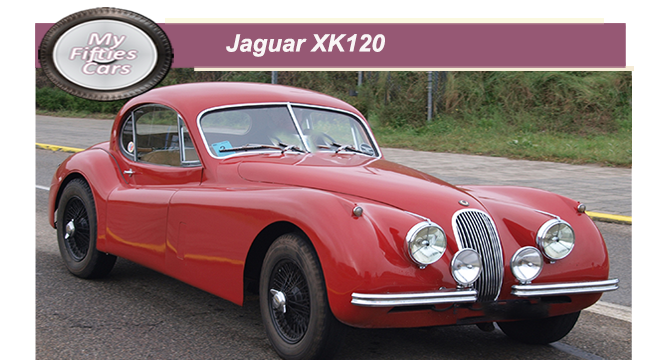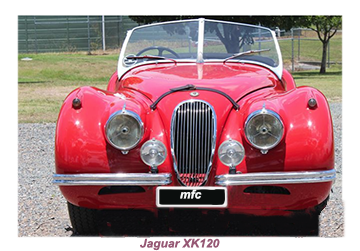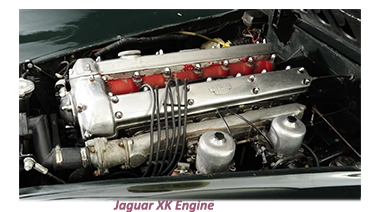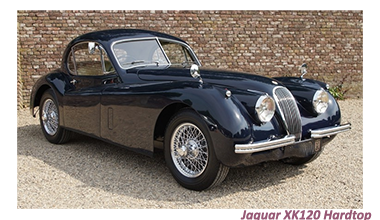
After suffering the hardships of World War II, the UK motoring public were ready to have their spirits lifted, and the Jaguar succeeded in doing when Sir William Lyons took the wraps off the stunning Jaguar XK120 at the 1948 Earls Court Motor Show in London.
The stuff of dreams, both beautifully purposeful and very quick, the XK120, which stood for Jaguar's advanced 3.4-litre six-cylinder engine, fitted with twin SU carburettors.
The powerful 3.4-litre (210 cu in) unit want on to become a standard, fitted in numerous subsequent Jaguars and survived deep into the Nineties.
The '120' represented the top speed — exceptional performance for a road car at the time. With the windscreen removed, ceiling speed was 136 mph (220 km/h), comfortably confirming the XK 120's status as the world's fastest production car.
 In terms of design, the two-seater roadster, with its classically simple flowing lines, slender tail and deliciously exotic flush-sided body, was unparalleled at the time, whilst also setting new performance. standards.
In terms of design, the two-seater roadster, with its classically simple flowing lines, slender tail and deliciously exotic flush-sided body, was unparalleled at the time, whilst also setting new performance. standards.
 Producing a silky smooth power delivery, this remarkable engine was the fruit of a long term project that the design and engineering team at Jaguar had been working on for manyyears.
Producing a silky smooth power delivery, this remarkable engine was the fruit of a long term project that the design and engineering team at Jaguar had been working on for manyyears.
 Even then the 3.4-litre (210 cu in) unit was so far ahead of its time , released when no other company were fitting mass-produced twin-camshaft engines- especially one that was easily capable of reaching 120mph (192km/h).
Even then the 3.4-litre (210 cu in) unit was so far ahead of its time , released when no other company were fitting mass-produced twin-camshaft engines- especially one that was easily capable of reaching 120mph (192km/h).
With so much power under its hood, it's little wonder the XK120 was lauded as being one of the fastest production cars in the world at that time.
![]()
Jaguar, although silently optimistic, set out with their usual restrained run of just 200 cars, with the first examples constructed using a wooden ash body frame and aluminium skin panels.
 However, it became rapidly apparent to Sir William and his management team at Jaguar that the massive impact for the XK120 would demand a switch to steel bodied cars at a much higher production rate.
However, it became rapidly apparent to Sir William and his management team at Jaguar that the massive impact for the XK120 would demand a switch to steel bodied cars at a much higher production rate.
The early alloy-bodied roadsters now command twice the value of the steel-bodied cars. Interestingly, however, the steel-bodied vehicles were actually lighter in weight.
 With demand steadily rising, Jaguar began to expand the ranges of choices around the XK120, with an elegant fixed-head version of the car released in 1951, with its bulbous roofline reminiscent of the Bugatti coupes of the Nineteen Thirties.
With demand steadily rising, Jaguar began to expand the ranges of choices around the XK120, with an elegant fixed-head version of the car released in 1951, with its bulbous roofline reminiscent of the Bugatti coupes of the Nineteen Thirties.
 Next to come was a delightful drophead coupe released in 1953 with a more luxurious interior and walnut veneer dashboard.
Next to come was a delightful drophead coupe released in 1953 with a more luxurious interior and walnut veneer dashboard.
The roadster's detachable side-screens and canvas top stowed behind the seats while the windscreen could be removed and performance-enhancing aero-screens fitted.
The convertible had a hood that folded back onto the rear deck, wind-up windows and fixed windshield.
Considerable development continued during the next six years,even while the XK120 was in production.
 Two updated versions of the engine were offered, producing 180bhp and 210bhp respectively.
Two updated versions of the engine were offered, producing 180bhp and 210bhp respectively.
Such was the impact of these update engines, that a number of existing XK120 owners paid what was required to their car’s engines to be converted retrospectively.
![]()
 Staking their special place in motoring history were the first few hundred hand-built versions of the Jaguar XK 120 with aluminium bodies fitted over ash frames.
Staking their special place in motoring history were the first few hundred hand-built versions of the Jaguar XK 120 with aluminium bodies fitted over ash frames.
 Many of the original XK12Os have remained more or less intact and increased tremendously in value.
Many of the original XK12Os have remained more or less intact and increased tremendously in value.
During their six-year production run, over 12,000 were built, making the XK 120 a great British success story – an all-new Jaguar sports car which changed the face not only of Jaguar, but also British sports car motoring, and set the standards for performance cars all over the world.


